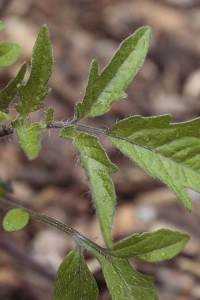One of the carnivorous plant lists I’m on has been buzzing a bit lately about an article that appeared in the Botanical Journal of the Linnean Society, “Murderous plants: Victorian Gothic, Darwin and modern insights into vegetable carnivory.” (See the abstract: here.) What really got things going was a sensationalized story in the London Telegraph, with the catchy title: “Tomatoes can ‘eat’ insects!” (The exclamation point is mine, but it seemed right for many titles published by the Telegraph.)
The basic premise is that hairs on tomato plants can catch and kill some small insects. The dead insects fall to the ground and nourish the plant. The botanical technique is called “passive carnivory,” in opposition to the active carnivory practiced by plants like sarracenia that have means to both capture and digest prey.
It’s kinduv a stretch, pulling a number of plants into what before was a select club of carnivores. The Telegraph article mentions “petunia, ornamental tobacco plants, some varieties of potatoes and tomatoes, and shepherd’s purse, a relative of cabbages.” The Linnean Society abstract goes on to mention plants “such as Stylidium (Stylidiaceae), some species of Potentilla (Rosaceae), Proboscidea (Martyniaceae) and Geranium (Geraniaceae), that have been demonstrated to both produce digestive enzymes on their epidermal surfaces and be capable of absorbing the products.”
That got the carnivorous plant folks to stretch the definition further. What about New Zealand’s bird-eating para ara tree? Maybe even the California fan palm with its hazardous sawtooth petioles? While I’m at it I might as well add one of my own nominations: eucalyptus, the Australian widow-maker. After our windstorm Monday night I noticed all sorts of eucalyptus branches on the ground. If you were around when some of the eight-inch-thick branches fell off, you’d be on your way to being nourishing compost for the plants!


HA! I’ll add our giant Norway Spruces to the carnivourous list, but really it’s the squirrels in June setting loose hundreds of green pinecones on our heads. Followers of the Australian Widowmaker?
How interesting! I’m glad I am not an insect! I spend so much time around tomato plants!
Glad you didn’t fall prey to your eucalyptus 🙂 I had no idea tomato plants do this. I’ve photographed their hairs before, especially because they’re lovely in certain lights. However, I think “carnivorous” might be a bit of a stretch. Sounds more like a clever defense to me.
Seems like a stretch to me, not exactly little shop of horrors. I noticed a flytrap pollen in the national geographic electron microscopy photos, might interest you.
http://ngm.nationalgeographic.com/2009/12/pollen/oeggerli-photography
Lynn, I’ll watch out for those Norway spruces…
Tatyana, more reason to be extra-nice to your tomatoes!
Meredith, I agree that it’s a bit of a stretch. By this definition you’d be able to fit any plant that was toxic to any animal species into being a carnivore.
Ryan, amazing pollen! The flytrap pollen looks as scary as the flytraps themselves. Makes me glad I’m a little larger than a pollen grain.
Sounds like a little stretch. I think more insects eat mine than croak. Glad you escaped the falling branches. Nice heavy rain storm here, hope you guys got it too.
Oh, too funny! I’d at least call those tomatoes omnivores, myself.
How interesting. I recall seeing little dead flies or gnats caught in the hairs of tomato leaves… that is about as far as it goes for any violence noted from the plant towards the insect by this gardener. I have seen and tried to aid a wild honey bee with milkweed pollen attached to its feet… neither the bee nor I were able to remove the pollen… odd behavior for pollen. It is a dangerous world out there.
Catching up on your posts – this one is too fascinating, and you gave me a chuckle. I read an interesting article in the NY Times about plant reactions – “At the smallest nip to its leaves, specialized cells on the plant’s surface release chemicals to irritate the predator or sticky goo to entrap it. Genes in the plant’s DNA are activated to wage systemwide chemical warfare…” You have to skip half way down the article to get past the annoying journalist fluff (like a latte with too much foam) – here’s the link: http://www.nytimes.com/2009/12/22/science/22angi.html.
Yeah, I just heard that Tomatoes and Potatoes were passively carnivorous too. I bet Darwin would be stupefied. To think people actually eat a carnivorous plant…… Though it is kind of cool to say i eat carnivorous plants for lunch ha! Anyways, thanks for creating this page, it really was surprising.